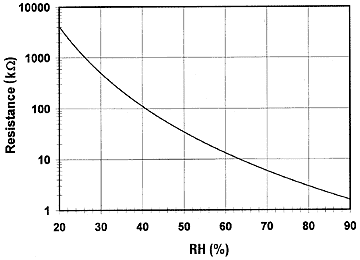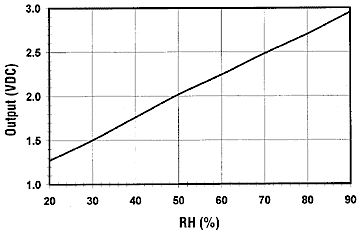
Resistive Humidity Sensors
Resistive humidity sensors measure the change in electrical impedance of a hygroscopic medium such as a conductive polymer, salt, or treated substrate.
Resistive sensors are based on an interdigitated or bifilar winding. After deposition of a hydroscopic polymer coating, their resistance changes inversely with humidity. The Dunmore sensor (far right) is shown 1/3 size. The impedance change is typically an inverse exponential relationship to humidity.

Figure 2. The exponential response of the resistive sensor, plotted here at 25 degrees C, is linearized by a signal conditioner for direct meter reading or process control.
Resistive sensors usually consist of noble metal electrodes either deposited on a substrate by photoresist techniques or wire-wound electrodes on a plastic or glass cylinder. The substrate is coated with a salt or conductive polymer. When it is dissolved or suspended in a liquid binder it functions as a vehicle to evenly coat the sensor. Alternatively, the substrate may be treated with activating chemicals such as acid.
The sensor absorbs the water vapor and ionic functional groups are dissociated, resulting in an increase in electrical conductivity. The response time for most resistive sensors ranges from 10 to 30 s for a 63% step change. The impedance range of typical resistive elements varies from 1000 ohms to 100,000,000 ohms.
Most resistive sensors use symmetrical AC excitation voltage with no DC bias to prevent polarization of the sensor. The resulting current flow is converted and rectified to a DC voltage signal for additional scaling, amplification, linearization, or A/DRconversion (see Figure 3).

Figure 3. Resistive sensors exhibit a nonlinear response to changes in humidity. This response may be linearized by analog or digital methods. Typical variable resistance extends from a few kilohms to 100 MV.
Nominal excitation frequency is from 30 Hz to 10 kHz.
The "resistive" sensor is not purely resistive in that capacitive effects makes the response an impedance measurement. A distinct advantage of resistive RH sensors is their interchangeability, usually within plus-minus 2% RH, which allows the electronic signal conditioning circuitry to be calibrated by a resistor at a fixed RH point. This eliminates the need for humidity calibration standards, so resistive humidity sensors are generally field replaceable.
The accuracy of individual resistive humidity sensors may be confirmed by testing in an RH calibration chamber or by a computer-based DA system referenced to standardized humidity-controlled environment. Nominal operating temperature of resistive sensors ranges from -40 degrees C to 100 degrees C.
In residential and commercial environments, the life expectancy of these sensors is >>5 yr., but exposure to chemical vapors and other contaminants such as oil mist may lead to premature failure. Another drawback of some resistive sensors is their tendency to shift values when exposed to condensation if a water-soluble coating is used.
Resistive humidity sensors have significant temperature dependencies when installed in an environment with large (>10 degrees F) temperature fluctuations. Simultaneous temperature compensation is incorporated for accuracy. The small size, low cost, interchangeability, and long-term stability make these resistive sensors suitable for use in control and display products for industrial, commercial, and residential applications.
One of the first mass-produced humidity sensors was the Dunmore type, developed by NIST in the 1940s and still in use today. It consists of a dual winding of palladium wire on a plastic cylinder that is then coated with a mixture of polyvinyl alcohol (binder) and either lithium bromide or lithium chloride. Varying the concentration of LiBr or LiCl results in very high resolution sensors that cover humidity spans of 20%-40% RH.
For very low RH control function in the 1%-2% RH range, accuracies of 0.1% can be achieved. Dunmore sensors are widely used in precision air conditioning controls to maintain the environment of computer rooms and as monitors for pressurized transmission lines, antennas, and waveguides used in telecommunications.
The latest development in resistive humidity sensors uses a ceramic coating to overcome limitations in environments where condensation occurs. The sensors consist of a ceramic substrate with noble metal electrodes deposited by a photoresist process. The substrate surface is coated with a conductive polymer/ceramic binder mixture, and the sensor is installed in a protective plastic housing with a dust filter.
The binding material is a ceramic powder suspended in liquid form. After the surface is coated and air dried, the sensors are heat treated. The process results in a clear non-water-soluble thick film coating that fully recovers from exposure to condensation.
This document saved from http://www.sensorsmag.com/articles/0701/54/main.shtml
General Electronics
- L298N Motor Controller Theory and Projects
- Build a Thermocouple Amplifier
- Build a Potato battery
- Testing a Diac
- Basic Triacs and SCRs
- Solid State AC Relays with Triacs
- Light Activated Silicon Controlled Rectifier (LASCR)
- Basic Transistor Driver Circuits for Micro-Controllers
- Opto-Isolated Transistor Drivers for Micro-Controllers
- Build a H-Bridge Motor Control with Power MOSFETS
- Series/Parallel batteries
- Using a CdS Photocells
- Voltage Comparator Information And Circuits
- Resistive Humidity Sensors
- Reed Switches
- Diodes and Rectifiers
Added January 2012: PICAXE Micro-controller Projects!
The PICAXE series of micro-controllers rank as the easiest and most cost effective way to use Microchip processors. I wanted an easier and less expensive way to introduce my students to the "PIC" micro-controller. Here I hope to get those starting out past poorly written literature and lack of simple working code examples.
- Exploring the PICAXE Micro-Controller
- Solar Panel Charge Controller Using PICAXE Microcontroller
- Understanding Micro-Controller Input/Output Ports
- Using the 74HC165 Shift Register with the PICAXE Micro-Controller
- Connecting the 74HC595 Shift Register to PICAXE Micro-controller
- Using 7-Segment Displays with the PICAXE Micro-Controller
- Potentiometers and Analog-to-Digital Conversion with the PICAXE
- PWM Motor Speed Control and the PICAXE Micro-Controller
- Connecting the PICAXE to the DS1307 Real Time Clock
- Connecting the PICAXE to an External EEPROM (24LC08)
- Connecting a Servo to a PICAXE
- Connecting the TLC548 ADC to the PICAXE
- Connecting the AD5220 Digital Potentiometer to the PICAXE